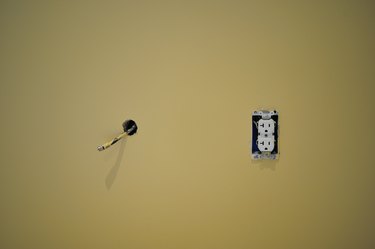
Got a three-prong plug that doesn't work anymore? Maybe it had a loose connection and arcing melted the plastic when you plugged it in, or maybe one of the prongs is missing. No worries. Replacing a three-prong plug is easy. It's good to know how to do this because some power cords come without plugs, and you have to install your own. Also, knowing how to replace a plug on your extension cord can save you the $50 or $60 you'd spend on a new one. Keep in mind that if the plug has three prongs, the cord must have a ground wire, and once you finish the hookup, you should only plug the cord into a three-prong receptacle.
Extension Cord Plug Replacement
Video of the Day
It doesn't matter whether you're replacing an extension cord female end or a male end. The wiring is the same. The procedure requires a knife, screwdriver, wire snippers and pliers, and it's a lot easier to accomplish cleanly if you have a pair of wire strippers. If you're replacing the female end of the cord, be sure the male end is unplugged. That's an easy thing to remember to do, but if you forget, the results could be disastrous, especially if you're working outside in wet weather.
Video of the Day
You can replace the plugs on any extension cord, but if the cord is for exterior use, you'll want to get plugs that are also rated for exterior use. They are sealed against moisture and feature a cord clamp to anchor the cord firmly to the plug.
Replacing a Three-Prong Plug
Start by cutting off the old plug about two inches away from the connection point using wire snips. Strip back about an inch of the plastic or rubber sheathing using a knife, and discard the sheathing. You now have three exposed wires. Extension cord wire colors are black (hot), white (neutral) and green (ground). Keep these in mind because each wire attaches to a particular terminal screw in the plug.
Most replacement plugs consist of two sections. Unscrew the plug and separate the sections, then twist the wires in the cord together and feed the cord through the bottom section. Separate the wires and strip an inch of insulation off the end of each one using a knife or wire strippers.
Make Connections the Right Way
Wrap the black wire clockwise around the brass terminal screw in the upper plug housing and tighten the screw with a screwdriver. You want to wrap clockwise because that's the screw direction. Tightening the screw draws the wire around the screw and makes a secure connection. Connect the white wire to the chrome terminal screw and the green wire to the green ground screw in the same way. If you're working on an interior cord, the ground wire may be bare. It still goes on the green ground screw.
Finish up by tightening the cord clamp and ensuring that no exposed wires are visible outside the plug housing. If there are, disconnect everything and shorten the wires a little. Finally, join the two sections of the plug housing and fasten them with the screws provided.